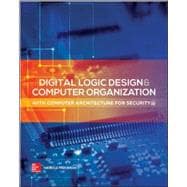A COMPREHENSIVE GUIDE TO THE DESIGN & ORGANIZATION OF MODERN COMPUTING SYSTEMS
Digital Logic Design and Computer Organization with Computer Architecture for Security provides practicing engineers and students with a clear understanding of computer hardware technologies. The fundamentals of digital logic design as well as the use of the Verilog hardware description language are discussed. The book covers computer organization and architecture, modern design concepts, and computer security through hardware.
Techniques for designing both small and large combinational and sequential circuits are thoroughly explained. This detailed reference addresses memory technologies, CPU design and techniques to increase performance, microcomputer architecture, including "plug and play" device interface, and memory hierarchy. A chapter on security engineering methodology as it applies to computer architecture concludes the book. Sample problems, design examples, and detailed diagrams are provided throughout this practical resource.
COVERAGE INCLUDES:
- Combinational circuits: small designs
- Combinational circuits: large designs
- Sequential circuits: core modules
- Sequential circuits: small designs
- Sequential circuits: large designs
- Memory
- Instruction set architecture
- Computer architecture: interconnection
- Memory system
- Computer architecture: security








